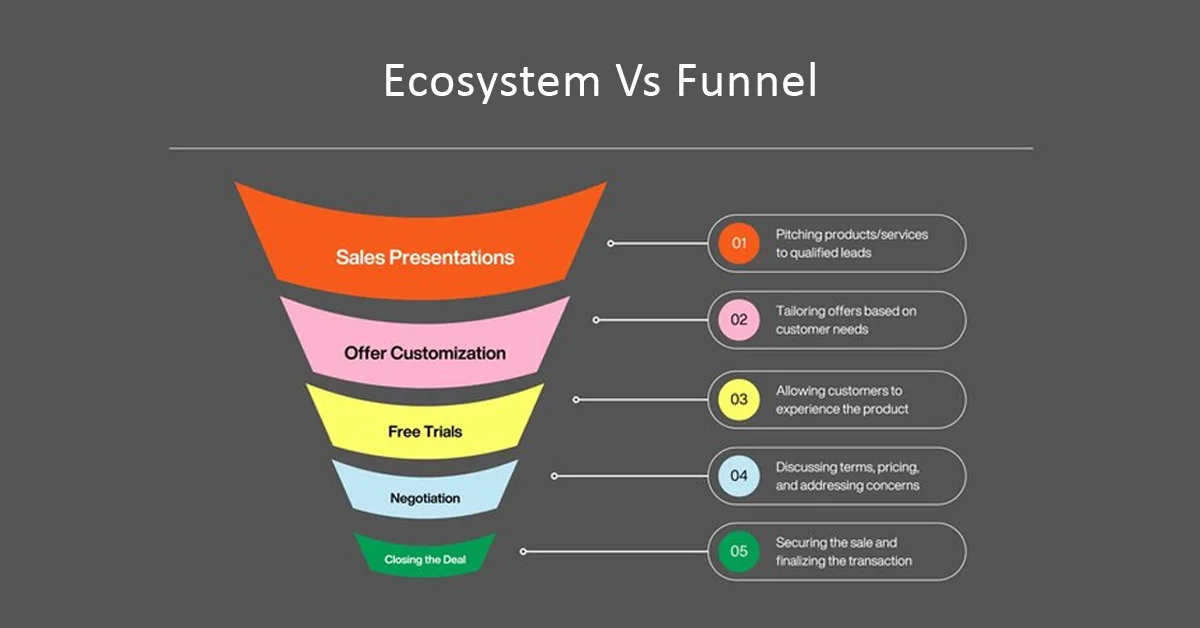In the world of business, marketing strategies play a crucial role in determining success. Among the various strategies, the ecosystem vs funnel approaches stand out for their unique methodologies in guiding potential customers toward making a purchase. Understanding these two strategies is vital for businesses aiming to optimize their marketing efforts. This article delves into the differences between ecosystems and funnels, analyzing their effectiveness and providing insights to help businesses choose the right strategy for their needs.
ALSO READ: Aliens HTB Write Up: A Complete Guide For Ethical Hackers
Understanding The Funnel Strategy
What is a Funnel?
The funnel strategy is a linear approach that depicts the customer journey from awareness to conversion. The term “funnel” illustrates how potential customers are gradually filtered down through different stages of the purchasing process.
The Stages of the Funnel
Awareness: Potential customers first learn about a product or service.
Interest: They show interest by engaging with content, such as articles or social media posts.
Consideration: Customers evaluate the options available and compare them.
Intent: They express intent to purchase through actions like adding items to a cart.
Purchase: The final conversion stage where the customer completes the transaction.
Loyalty: Post-purchase, where efforts are made to retain customers for repeat business.
Advantages of the Funnel Strategy
Simplicity: The funnel model is straightforward and easy to understand. Businesses can map their marketing efforts clearly to each stage.
Measurable Metrics: Each stage of the funnel has specific metrics that can be tracked, such as conversion rates and customer acquisition costs.
Targeted Marketing: Marketers can create tailored content and campaigns for each stage, making it easier to guide customers toward making a purchase.
Challenges of the Funnel Strategy
Linear Approach: The funnel assumes a linear customer journey, which may not reflect real-world behavior, as customers often skip stages or loop back.
Neglects Post-Purchase Engagement: Once the sale is made, the focus on the funnel can diminish, risking customer retention and loyalty.
Limited Scope: The funnel does not account for the broader ecosystem of interactions that influence purchasing decisions.
Understanding The Ecosystem Strategy
What is an Ecosystem?
The ecosystem strategy encompasses a broader view of the customer journey, acknowledging that purchasing decisions are influenced by a multitude of factors beyond a single brand’s marketing efforts. It recognizes the interconnectedness of various channels, touchpoints, and interactions within the market.
Key Components of the Ecosystem
Multiple Touchpoints: Customers engage with a brand through various channels, including social media, email, websites, and physical stores.
Collaborative Partnerships: Brands can collaborate with other companies or influencers to enhance credibility and reach.
Community Building: Fostering a community around a brand encourages engagement and loyalty.
Advantages of the Ecosystem Strategy
Holistic View: The ecosystem approach allows businesses to understand customer behavior in a more nuanced way, capturing the complexity of the buying journey.
Enhanced Customer Relationships: By focusing on community and engagement, brands can build stronger relationships with their customers.
Adaptability: The ecosystem strategy can evolve with market trends and customer preferences, allowing for greater flexibility in marketing efforts.
Challenges of the Ecosystem Strategy
Complexity: Managing multiple channels and partnerships can be overwhelming, requiring more resources and coordination.
Measurement Difficulties: Tracking the effectiveness of an ecosystem approach can be challenging due to the numerous variables involved.
Long-Term Commitment: Building an ecosystem takes time and effort, and immediate results may not be evident.
Comparing Ecosystem And Funnel Strategies
Focus on Customer Journey
- Funnel: Primarily focuses on the steps leading to a purchase, often neglecting the post-purchase phase.
- Ecosystem: Considers the entire customer journey, including pre-purchase, purchase, and post-purchase interactions.
Engagement Level
- Funnel: Engagement is primarily transactional, aimed at moving customers through specific stages.
- Ecosystem: Engagement is relational, fostering ongoing relationships and community involvement.
Flexibility and Adaptability
- Funnel: Generally rigid in its linear progression, making it less adaptable to changing customer behaviors.
- Ecosystem: Highly adaptable, allowing businesses to pivot strategies based on real-time feedback and market trends.
Metrics and Measurement
- Funnel: Provides clear metrics for each stage, making it easy to measure success.
- Ecosystem: Metrics can be complex and multifaceted, requiring more sophisticated tracking and analysis.
Which Strategy Drives More Success?
The effectiveness of either strategy ultimately depends on the nature of the business, its target audience, and its goals. Here are some factors to consider when choosing between an ecosystem and a funnel approach:
Industry Type
- B2B vs. B2C: B2B businesses may benefit more from an ecosystem strategy, as building relationships and partnerships is crucial. Conversely, B2C businesses might find the funnel strategy effective for driving immediate sales.
Customer Preferences
- Research-Oriented Customers: If your customers tend to research extensively before making a purchase, an ecosystem approach that provides ample information and resources may be more beneficial.
- Impulsive Buyers: If your target audience tends to make quick decisions, a funnel approach that emphasizes urgency and clear calls to action may drive better results.
Business Objectives
- Short-Term Sales Goals: If your focus is on short-term sales, the funnel strategy may be more effective in guiding customers to complete a purchase quickly.
- Long-Term Brand Loyalty: If your goal is to build long-term relationships and brand loyalty, the ecosystem strategy may better serve your needs by fostering engagement.
Marketing Resources
- Team Size and Expertise: The funnel strategy may be easier to implement for small teams with limited resources, while the ecosystem approach may require more extensive collaboration and coordination among various departments.
Conclusion
In conclusion, both the ecosystem and funnel strategies offer distinct advantages and challenges. The funnel approach provides a clear, linear path to conversion, making it easier to measure and manage. However, it may fall short in fostering long-term customer relationships. On the other hand, the ecosystem strategy embraces the complexity of customer interactions, promoting engagement and community building but requiring more effort to manage and measure.
Ultimately, the choice between the two strategies should align with your business objectives, customer preferences, and available resources. Many businesses may find that a hybrid approach, incorporating elements of both strategies, yields the best results in today’s dynamic market landscape.
ALSO READ: Experience A Dream Spiritual Mayan Journey For Soul Awakening
FAQs
What is a funnel strategy in marketing?
A funnel strategy in marketing refers to a model that outlines the customer journey from awareness to purchase. It illustrates how potential customers progress through different stages, including awareness, interest, consideration, intent, and purchase, ultimately guiding them toward making a decision.
How does the ecosystem strategy differ from the funnel strategy?
The ecosystem strategy differs from the funnel strategy in that it encompasses a broader view of customer interactions, acknowledging multiple touchpoints and relationships that influence purchasing decisions. While the funnel focuses on a linear path to conversion, the ecosystem considers the entire customer journey, including post-purchase engagement.
Which strategy is better for long-term brand loyalty?
The ecosystem strategy is generally better for fostering long-term brand loyalty. By emphasizing community building, ongoing engagement, and customer relationships, businesses can cultivate a loyal customer base that continues to support the brand over time.
Can businesses use both strategies simultaneously?
Yes, many businesses successfully use both strategies simultaneously. A hybrid approach allows companies to leverage the clarity and measurable metrics of the funnel while also embracing the complexity and engagement opportunities of the ecosystem.
What factors should businesses consider when choosing a strategy?
Businesses should consider factors such as their industry type, customer preferences, business objectives, and available marketing resources when choosing between an ecosystem and funnel strategy. Each business’s unique context will influence which approach is most effective for driving success.

